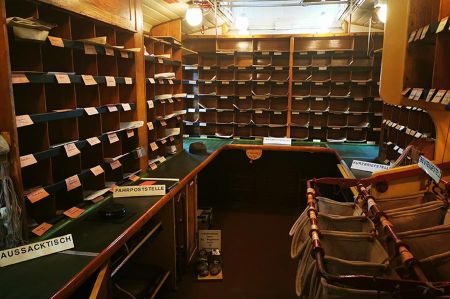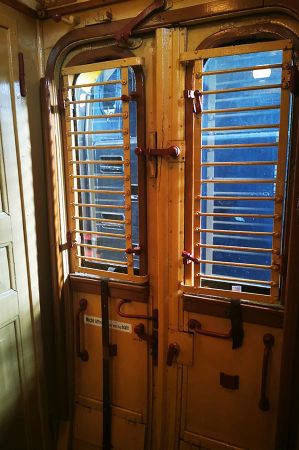Railway mail waggon in the Dahlhausen Railway Museum
- Written by Portal Editor
In a first article we had pointed out the Railway Museum as a place to get involved in Bochum-Dahlhausen, which we could easily reach on foot or by bike from our campsite "Horster Ruhrbrücke".
We had also already announced further articles on the subject of railways, and that today we would like to start with a report on a very interesting mail van on display in the museum, the railway mail or parcel van from the Frankfurt 19 railway post office.
Functions of the railway mail van for letter and parcel traffic
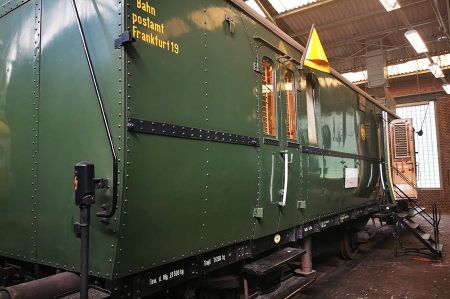 Here you can see once again how our letter mail was processed and transported over the last two centuries, without the Internet or email.
Here you can see once again how our letter mail was processed and transported over the last two centuries, without the Internet or email.
When the railway system began to develop in the 1840s, almost 200 years ago, postal administrations were already using rail to transport mail.
Today, people are trying to make rail attractive again using a variety of means, probably also in the late realization that it was a big mistake to focus solely on road transport. In the long term, it is clear once again that cheaper is not the solution to the problem.
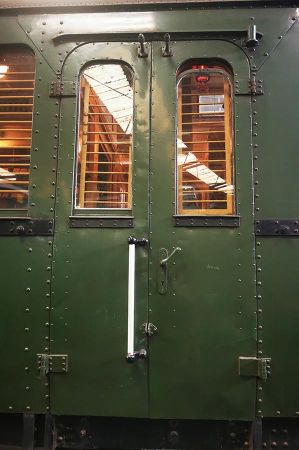 "Railway mail cars" running on the rails were introduced as early as 1841. From 1875, these postal vehicles were given the name "railway mail cars" (BPW) in what was then the Imperial German Post Office.
"Railway mail cars" running on the rails were introduced as early as 1841. From 1875, these postal vehicles were given the name "railway mail cars" (BPW) in what was then the Imperial German Post Office.
In addition to the rail mail cars, the railway's own cars were also used to transport mail, whether in the form of covered freight cars for parcel transport or in the form of mail compartments in passenger coaches.
The rail mail cars are either placed individually in passenger trains or driven in larger numbers as part of express goods and freight trains with mail transport.
Development of the rail mail car design
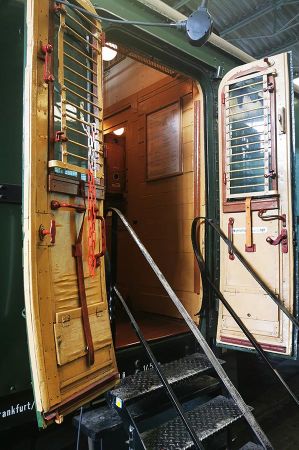 Letter and universal mail cars in which work is carried out during the journey or during shunting work require equipment that also makes them suitable as workplaces for postal workers.
Letter and universal mail cars in which work is carried out during the journey or during shunting work require equipment that also makes them suitable as workplaces for postal workers.
The requirements for the running gear are comparable to those for sleeping and couchette cars, and in addition, heating and lighting must be largely independent of the movement and supply from the train locomotive.
This was generally achieved by increasing battery capacity (hear, hear), additional axle generators and self-heating. Battery operation is therefore not really anything new. It's a shame that the development of batteries was not used, we would be much further ahead today.
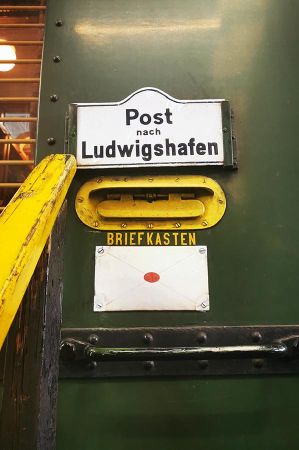 With a few exceptions, there were no plans for car crossings, as in order to protect the confidentiality of letters, rail mail cars were not allowed to be entered by anyone outside the post office, including rail employees.
With a few exceptions, there were no plans for car crossings, as in order to protect the confidentiality of letters, rail mail cars were not allowed to be entered by anyone outside the post office, including rail employees.
This also gave rise to the need to provide sanitary facilities. Entry areas at the ends of the cars often served as shunter's cabins with no connection to the rest of the car interior or with a door that could be locked from the inside.
Working in rail mail cars was not entirely safe, as one can easily imagine. Accidents kept happening, especially when cars occupied by postal employees were being shunted. In 1953, 161 such accidents occurred in the area of the German Federal Railway, with a total of 94 people injured.
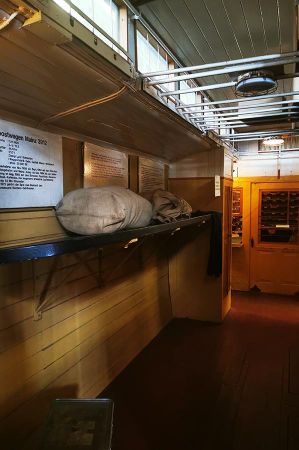 Until the beginning of the 20th century, letter bags were dropped at train stations as trains passed through. Letter bags were not allowed to weigh more than 6 kg.
Until the beginning of the 20th century, letter bags were dropped at train stations as trains passed through. Letter bags were not allowed to weigh more than 6 kg.
They were dropped slightly to the side in the direction of travel of the train "with moderate force". When the train reached the drop point, the locomotive driver gave a signal with the steam whistle. In the dark, the officer present on the platform to receive the bags carried a lantern with frosted glass panes, one of which was inscribed with the word POST.
This inscription was held up to the train. Since accidents or damage to mail often occurred when dropping mail, the German Reichspost stopped the practice in 1900, and Bavaria followed on May 1, 1904.
Types and marking of the railway mail cars
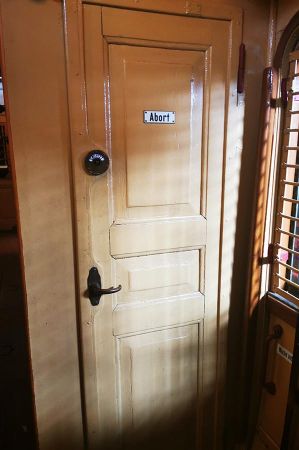 The letter mail is not only transported in the railway mail cars, but also processed, i.e. distributed according to locations and control units so that the valuable hours of travel time are used. The packages and parcel bags are also grouped together in stacks for the transshipment or destination offices along the route and, like the letter bags, exchanged at the relevant railway stations.
The letter mail is not only transported in the railway mail cars, but also processed, i.e. distributed according to locations and control units so that the valuable hours of travel time are used. The packages and parcel bags are also grouped together in stacks for the transshipment or destination offices along the route and, like the letter bags, exchanged at the relevant railway stations.
For this work, an interior office-like, or better yet, mail sorting system is required, which is similar to that of a letter and parcel distribution point or a packing room in a post office. According to this, a distinction is made between three types of workrooms in the railway mail cars, which recur in various combinations in many types of cars:
- The "letter room" equipped with work tables and letter distribution frameworks for letter distribution,
- The "unbagging room" equipped with a large work table (some with dust extraction) for emptying the bags with mail to be processed and a large bag clamping device for holding the initially empty letter bags, which then hold bundles of letters,
- and the "parcel or packing room" which is equipped with packing boards along the side walls and a rod grate (packing rods) stretched over the entire area at a height of 2 m to accommodate the largest possible amount of coarse cargo (parcels, parcel sacks, parcel bags, postal newspapers).
Railway mail cars often had a slot for mail from the platform, similar to the slot on post boxes. BPW has had its own marking since 1852 (Prussia). The German Reichsbahn and the German Reichspost continued this Prussian numbering system. The founding of the German Federal Post Office and the German Post Office (GDR) after 1945 led to different designs at BPW and, accordingly, to divergent markings, which often led to problems.
Railway postmarks and German regulatory system
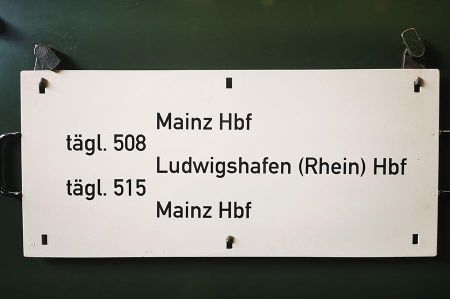 The mail car exhibited in Bochum-Dahlhausen once belonged to the Frankfurt 19 railway post office, Frankfurt am Main railway post office 19 foreign office, German Reich 1933-1945 with its own post office stamp.
The mail car exhibited in Bochum-Dahlhausen once belonged to the Frankfurt 19 railway post office, Frankfurt am Main railway post office 19 foreign office, German Reich 1933-1945 with its own post office stamp.
The first railway postmarks were made in a wide variety of shapes. There were single-circle and double-circle stamps, stamps with octagonal frames. In the area of the North German Confederation, the so-called Prussian three-line stamps can be found. With order no. 93 of the first department of the Reichs-Postamt on September 21, 1883, the introduction of oval course stamps (blunt oval) with train numbers corresponding to the railway timetable was ordered. In 1906, the introduction of a new oval stamp (pointed oval) was decreed.
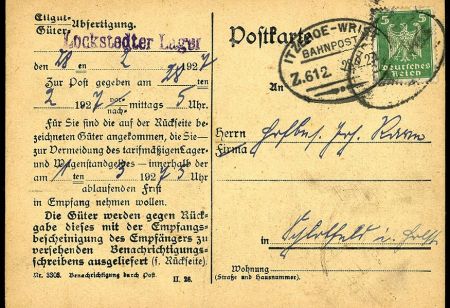 However, this decree only came into force for new railway lines, and the blunt oval stamps were to be replaced by the pointed oval stamps when they were worn out. In contrast to the blunt oval stamps, which had plug-in types for the date and train number, the pointed oval stamps could be adjusted using type wheels. On some lines, the new introduction lasted until around 1930. According to decree no. 155 in the official gazette 20/1931, the stamps used at the railway posts were referred to as "route stamps". In September 1933, another change occurred when the Reichspostzentralamt declared in communication 427 482/1 that all stamps with route information were to be referred to as route stamps, and at railway posts specifically as "railway post stamps".
However, this decree only came into force for new railway lines, and the blunt oval stamps were to be replaced by the pointed oval stamps when they were worn out. In contrast to the blunt oval stamps, which had plug-in types for the date and train number, the pointed oval stamps could be adjusted using type wheels. On some lines, the new introduction lasted until around 1930. According to decree no. 155 in the official gazette 20/1931, the stamps used at the railway posts were referred to as "route stamps". In September 1933, another change occurred when the Reichspostzentralamt declared in communication 427 482/1 that all stamps with route information were to be referred to as route stamps, and at railway posts specifically as "railway post stamps".
Typically German, you could say. Everything well-ordered and sorted out.
Please read as well:
